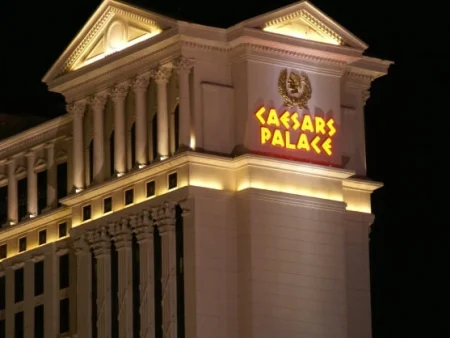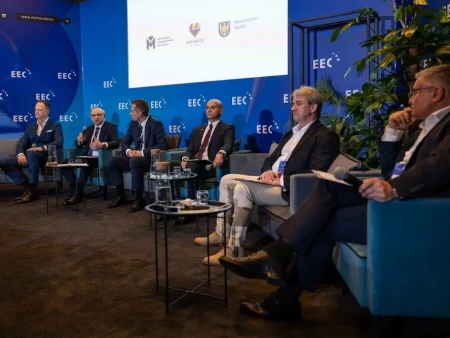As Fontainebleau Las Vegas casino resorts opens, Buck Wargo analyses why the latest launch is an indicator of the city targeting a wealthier market.
The opening of the $3.8 billion Fontainebleau Las Vegas casino resort this week feeds the narrative that the Strip is becoming more of a destination for wealthier visitors. While previously known as a marketplace once relished by tourists for its inexpensive rooms and cheap buffets, that’s now changing.
November’s inaugural Formula One race on the Strip attracted international jet setters and affluent households. This is now what is expected and desired by Las Vegas’ luxury resorts like the Wynn, Bellagio, The Cosmopolitan and others.
While the number of visitors is down compared to pre-Covid years, gaming and other revenues continue to increase. This is a sign people with more disposable income are coming to Las Vegas.
“We have heard anecdotal commentary that the sports and entertainment industry, which has developed in recent years, is attracting higher-end customers and displacing lower-tier players in Las Vegas,” said Michael Lawton, a senior economic analyst for the Nevada Gaming Control Board.
“I believe those comments are difficult to argue with based on the numbers that we have been releasing,” he added.
Analysing the demographics
The numbers bear out that the trend line for Las Vegas in an era post-Covid is one in which wealthier US households had some of the highest income gains of any group.
A survey by the Las Vegas Convention and Visitors Authority shows that 44% of the visitors during the third quarter of 2023 had household incomes of $100,000 and above. That’s up from 33% during the third quarter of 2022.
In 2021, the first survey after the pandemic, 30% of visitors exceeded $100,000 in household income, about the same as it was in 2019 at 29%. Those households between $80,000 and $100,000 made up 20% of visitors this year, up from 16% a year ago.
In contrast, those households with lower incomes made up a smaller percentage as costs such as food and entertainment increased. Some 8% of visitors with household income below $40,000 made up the visitor pool in 2023. This was down from 16% in 2019 prior to the pandemic.
Those households making between $40,000 and $60,000 made up 10% of the visitors this year. That is again down from 17% a year ago.
“Las Vegas has become a premier destination. I suppose F1 is emblematic of that shift,” said Oliver Lovat, CEO of the Denstone Group.
“We have the world’s most exclusive sport coming to Las Vegas. They wouldn’t have come here if we were all about $1.99 shrimp cocktails and $5 buffets. This is an elite offering in Las Vegas. You can come and do things here you can’t do in any other city. You can’t go to the shows and restaurants in New York, London or Paris at the same scale of offerings as Las Vegas.”
Some two-thirds of casino revenue is now from non-gaming amenities. That is quite the shift from three decades ago when the percentages were reversed.
The return of luxury
While Las Vegas has previously focused on luxury with the Bellagio opening in 1999 and Wynn in 2005 and other subsequent openings, the pandemic brought about a pause. This is now returning, with offerings now elevated to make Las Vegas a destination for the wealthy, Lovat said.
“If you look at table games, you won’t find a $5 anything on the Strip anymore,” Lovat said. “They took out all the underperforming restaurants and put in places more aligned with who the customers are. We’ve seen that effect with the type of people coming here.”
Las Vegas is known for its first-class food and beverage programmes that are as good as anything across the world. The Mayfair Supper Club at the Bellagio and Delilah Lounge & Fine Dining at the Wynn are cited as examples of high-end cabaret-style establishments that epitomise the Strip.
“I was in London and chatting with a bunch of guys in the food and beverage world. They were telling me that the prices in Las Vegas are higher than those in London,” said Lovat, a Scottish native who now lives in Las Vegas. “People are noticing what’s going on here. It used to be that Las Vegas would look at what’s going on in other cities and try to bring it here.”
As for entertainment, Lovat said Las Vegas has long described itself as the “Entertainment Capital of the World”. However, that moniker is true today with top-tier concerts in venues such as the newly-opened Sphere, T-Mobile Arena and concert venues at various casinos.
“They’re packed,” Lovat said. “Just go on a Saturday night and look at the offerings on the Strip. It’s the best in any city of the world every week. You have had U2, Lady Gaga, Katy Perry, Adele, Garth Brooks and Pink. And you have soccer matches and American football with the Raiders (at Allegiant that opened in 2020) and NHL Champion Vegas Golden Knights (at T-Mobile Arena). You can have three different experiences on three different nights.”
The average budget for visitors who gambled during their trip was $851 during the third quarter. This was up from $591 in 2019, according to the LVCVA. Some 84% gambled.
Spending per visitor for food and beverage also increased to $575 during the third quarter compared to $415 in 2019. Retail shopping spending hit $427 during the third quarter, up from $281 in 2019. Spending on shows and entertainment tripled from just over $100 in 2019 to nearly $300 during Q3 of 2023.
Fontainebleau Las Vegas opening
The opulent 67-floor Fontainebleau Las Vegas, modelled after the upscale Fontainebleau in Miami and featuring luxury retailers such as Giuseppe Zanotti and Italian fashion house Missoni, follows the trend line that was established with the Bellagio and Wynn.
The Palazzo next to the Wynn opened in 2007, which was followed by Wynn’s second phase in Encore in 2008. Aria at CityCenter opened in 2009 followed by The Cosmopolitan between Aria and the Bellagio in 2009. Resorts World was the latest Strip property that opened in 2021 until the Fontainebleau Las Vegas this week.
The expense it takes to build a resort on the Strip with high land prices makes catering to luxury guests the way to go for projects to pencil, observers say.
“If you go back and look at the last 10 to 15 years and look at all of the properties that have opened and look forward to Fontainebleau, they are all luxury-positioned properties including the Sphere, which is not a cheap date,” said Josh Swissman, founding partner of GMA Consulting.
Fontainebleau Las Vegas president Mark Tricano said the city “has emerged as a top-tier destination for luxury and entertainment, with the arrival of major sporting events, the best dining and nightlife and unparalleled levels of service.” The city competes on a global scale and attracts an international clientele who are seeking unique experiences, he added.
“As the newest luxury resort on the iconic Las Vegas Strip, Fontainebleau Las Vegas carries on a 70-year legacy that began in Miami Beach, blurring the line between the glamour of the past, the luxury of the present and the style of the future for our guests,” Tricano said.
“Our brand is geared toward assured tastemakers, who are sophisticated and travel in search of fun and invigorating, once-in-a-lifetime experiences. In turn, we are positioned to provide unforgettable moments with a variety of programming designed to appeal to all interests.”
That includes 36 food and beverage concepts from award-winning chefs and restaurateurs and “to the incredible level of design and fine art that we have curated throughout the resort and more. We are certain that what we have created will greatly enhance the luxury market in Las Vegas.”
Brendan Bussmann, managing partner of B Global, said the Fontainebleau Las Vegas is aiming for a mid-high to high-end customer. It’s a trend that has been long under way and shows no sign of slowing.
“It’s going to continue that way,” Bussmann said. “If you listen to the rumours of what’s coming, (billionaire casino owner) Tilman Fertitta wants to open a higher-end property. And there’s a rumour of a Ritz-Carlton hotel on the Strip.”
Luring high-end visitors
The LVCVA and Clark County officials said the potential of luring high-end visitors to Las Vegas and global marketing it achieves is why they invested in F1 coming to the city. Corey Padveen, a partner at t2 Marketing International, says F1 coming to Las Vegas cements the city as a luxury destination not unlike Monaco and Miami where a race is held.
“F1 is the cherry on top of that growth sundae,” Padveen states. “It’s been a long time since Vegas has been a budget-friendly destination. It used to be if you spent two hours at the table they would comp your food, drinks and room. The comp structure has changed a lot so you’re not just rewarded for playing.
“They want you on property spending money throughout the day. Gambling is still important, but we’ve seen entertainment, food and rooms gaining more of a share in the overall economy in Las Vegas for some time. Despite how many rooms there are, you’re not going to get a room under $100 or $200 and stay on the Strip for the low cost you were able to get as recently five to 10 years ago. It really has shifted, especially, in the last couple of years, to a luxury tourist market.”
Padveen sees the reason being that visitors can go to Las Vegas and spend $5,000 for a weekend and live like royalty. If they go to Monaco on the same budget, they’re not going to get the same level of experience. Those who are spontaneous travellers and decide they want to hop on a plane and go to Las Vegas for the weekend come from higher income brackets, he added.
“It’s become more of a luxury destination over time and Covid expedited that,” Padveen said. “You went from zero travel to pent-up demand. A big portion of that is coming from higher-end individuals who could afford to go because they were part of groups that didn’t lose their jobs or had to change budgets around.”
Las Vegas needs to be a place that attracts higher-end visitors. This is especially the case given that labour costs are rising with a new agreement with unions, overall inflation, costs of security and service of guests, Padveen said.
Focusing on high net-worth
C3 Gaming principal Lawrence Shen, said some public gaming companies on the Strip are overly focused on higher-worth players. This is in place of focusing on value tourists to grow their business. While this could propel growth in the short term, the fast growth would also become difficult targets to hit in the future.
This is based on the assumption that it will require continued growth from the stock market. Such a focus makes executives more inclined to increase prices and targeting higher-worth players again and again. It will slowly alienate value tourists, he added.
Las Vegas can no longer be characterised as a value gaming destination. Instead it’s fast-becoming an expensive place to take a vacation. This is while many regional markets offer better vacation value, according to Andrew Klebanow, principal at C3 Gaming.
For example. those seeking a party experience get far better value going to Nashville. Gamblers, meanwhile, can get more affordable vacation experiences in the regional markets. Airfares have been high too, which probably has discouraged some segments of the population from flying, he said.
Strip room rates continue to increase and hit $251 in October. That’s an 11% increase over 2022. They will be even higher in November, once F1 figures are released, based on casinos such as MGM Resorts International reporting record hotel revenue. Average Strip rates were often below $150 a night before the pandemic.
“You could go down there and stay in a hotel for $35 a night, have a steak dinner for 17 bucks and hit the tables and play $5 blackjack,” Padveen said. “There aren’t too many big places that still offer $5 blackjack. You would be lucky to find something at $15. Your standard is going to $25 and your minimum at night is going up to $50 if you’re playing craps. Not too many people can enjoy the full scope of entertainment when you’re telling them to come down here with $500 to $600 if you want to get any sort of fun on your time on the floor. You’re seeing them move away from the Strip if not outside of Las Vegas itself.”
As for those customers on the lower end of the household income spectrum, Lovat said the raise in prices means they’re not hanging out at the same places they were before. They are going downtown, even though that has become more expensive, or staying off the Strip or going to regional casinos that are more affordable, he says.
Lovat pointed out, however, that what Las Vegas does well is that it still has “something for everyone”. People won’t be able to stay in a room at the Bellagio for $50. But they will find other places to stay that are more affordable. While they won’t get a $10 buffet any longer, there are still less expensive dining options.”
The take from operators
Caesars Entertainment CEO, Tom Reeg, offers the operator’s take. On a recent earnings call with Wall Street analysts, Reeg highlighted that sporting events and entertainment are bringing in higher-end customers. At the same time, lower-tier players from Las Vegas are being pushed out. This is a trendline that will boost the financial performance of casino operators in the future.
Reeg has dismissed fears from analysts that Las Vegas is hitting a peak that won’t be surpassed. He forecasts adjusted earnings of $5bn in 2025 as they target higher-end customers.
“We all know that back in our parents’ days it was a very different market. [It was] low value and eating steak and lobster for a couple of bucks,” Reeg said. “Now you are talking about one of the best food and beverage scenes in the world among the best sports and entertainment in the world and we’re continually adding to that. MGM, Wynn (and others) are all working to up-tier what we’re offering the customer.”
The LVCVA helped bring in the Raiders in 2020 with the opening of Allegiant Stadium that has also hosted more than 60,000 people at sporting events and concerts. T- Mobile Arena has hosted the Vegas Golden Knights and concerts as well as other sporting events. Now there is also an added attraction in the Sphere.
Reeg cited the Raiders, F1, the return of convention goers and the planned $1.5bn baseball stadium on the south end of the Strip for the relocating Oakland A’s as offering bright prospects for the future.
“You’re bringing in higher value customers and you’re already full so you’re kicking out the lowest end,” Reeg said. “I see no reason that needs to stop or would stop.
“The market has done a great job over the 30 years I have been around gaming. It’s continuing to add reasons for people to come and continue to add capacity.”
In 2022, the average Las Vegas visitor spent a record $1,156 a trip. This is 33% higher than 2019 and boosts visitor spending to an all-time high of $44.9 billion. That is despite the city still falling 3.7 million short of 2019 visitation levels prior to the pandemic.
“I think you’re seeing Vegas as a market doing a fantastic job of continuing to add events. Franchises like Formula One bring a significantly more valuable customer to the market,” Reeg said. “If I look at Vegas now, all of us are pretty full. We’re all doing well here.
“Occupancy rates are quite high and it’s natural to say ‘how do you get better?’ You get better by up-tiering the average customer that is coming to the market. That’s what you can see in our own microcosm at Caesars over what’s happened in our business over the last three years. It’s the expense discipline but also the better average customer.”
Lovat said Las Vegas remains well positioned with its new customer base. This makes it more immune to economic downturns compared to visitors in the past. The future remains bright with a customer that has the ability and willingness to spend.
“Three years ago at the peak of Covid, people were worried about the long-term viability of Las Vegas,” Lovat said. “Nobody is worrying anymore.”
Original Article















